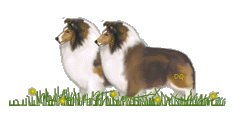|

It is extremely difficult to trace the early history of Shetland Sheepdogs, as no written records were kept. However, it seems that in the early 1800's visitors to the remote Shetland Isles brought them back to England and Scotland.
 |
| Today's Sheltie is a direct descendant of the small shepherding dog used in the Northern Islands of Scotland. The harsh climate and rough terrain of the islands does not make the ideal location to raise an abundance of large cattle. Vegetation is sparse on these islands and there are few places to hide from the severe North Sea storms that frequent the area. With limited food sources and space requirements, it is almost impossible for large species of cattle, or any other large land animal, to survive for long in the Shetlands.
Fortunately, nature has a way of solving its own problems. In order for animals to survive in the Shetland Islands, they had to be adaptable. Smaller, hardier animals could survive in this harsh environment, for they require less food and can find shelter in many more places than larger ones. So after many generations, literally all of the Shetland animals have become smaller and hardier than their mainland equivalents. The Shetland pony is another example of a well known animal that has become smaller in size to adapt to its surroundings, as have the sheep and cattle.

Sheltie in snow | Due to the remoteness of the islands it was not until 1909 that the Sheltie obtained initial recognition by the English Kennel Club, when it was classified as a Shetland Collie. In 1914 the breed obtained a separate classification and has since been known as the Shetland Sheepdog. The first Challenge Certificate was awarded to the breed in 1915.There have been many Shetland Sheepdog clubs formed. Their history has been very controversial in the acceptable size and type of the breed. The first club, the Shetland Sheepdog Club of the Islands, was founded in 1908. They required a "miniature rough collie" with a height of not more than 15 inches (38cm). Originally, The Scottish Shetland Sheepdog Club, which was founded in 1909 required an "ordinary collie in miniature", which was to be 12 inches high (30cm). The club later changed it's standard to "a modern show collie in miniature" at a height up to 13.5 inches (34cm). In 1914 the English Shetland Sheepdog Club was formed as a breakaway from the Scottish. Their preference was for "approximately a show collie in miniature", the ideal height to be 12 inches (30cm), this was later changed to a
more lenient range of 12 - 15 inches (30-38cm), with the ideal being 13.5 inches (34cm). A breakaway from the English Club is the British Breeders Association, and they asked for "a show collie in miniature" and keep the same heights as the English Club. Eventually, in 1930 the Scottish and English Clubs got together and changed their standards to "should resemble a collie (rough) in miniature".
For those who do not wish to show of course, heights etc., are far from important. A Shetland Sheepdog is a wonderful breed to own, due to it's wonderful nature and beautiful appearance, which make many people who are not dog lovers unable to walk by without a comment or a stroke. |
 |

